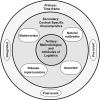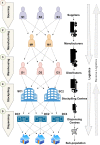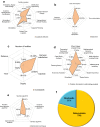Maintaining efficient logistics and supply chain management operations during and after coronavirus (COVID-19) pandemic: learning from the past experiences
- PMID: 33488274
- PMCID: PMC7813976
- DOI: 10.1007/s10668-020-01115-z
Maintaining efficient logistics and supply chain management operations during and after coronavirus (COVID-19) pandemic: learning from the past experiences
Abstract
The outbreak of the novel coronavirus (COVID-19) forced the governing bodies across the world to ban all kinds of travel involving the movement of people. However, the policymakers have been working hard to mobilize the movement of essential goods and services considering its importance in containing the pandemic. It signifies how important the establishment and maintenance of logistics and supply chain management (LSCM) operations are, both during the containment and the successive periods. Motivated with the paramount importance of LSCM operations during the rapid spread of the novel coronavirus (COVID-19) across the globe, this paper critically reviews the existing literature closely related to it. The main aim is to identify and enhance the understanding of the logistical characteristics that play a vital role during pandemics. The selection of the literature was done using Preferred Reporting Items for Systematic Reviews and Meta-Analysis (PRISMA) methodology. The classification of the selected literature was done using a tripartite framework. Results show that researchers have focused mostly on "Post-event" (48.24%) management of logistical operations followed by the "Pre-event" (31.76%) and least in the "Integrated" (20%.) approaches. Furthermore, the analysis of the results provided useful insights that are discussed in detail. Also, twelve key areas have been identified that need due attention to improve the overall efficiency of the LSCM operations. We believe that the findings from this paper would be useful to the decision-makers and other stakeholders, as far as, maintaining efficient LSCM operations during as well after the pandemics are concerned.
Keywords: Coronavirus/COVID-19; Decision-making; Emergency control logistics; Emergency supply chain; Pandemic.
© Springer Nature B.V. 2021.
Conflict of interest statement
Conflict of interestThe authors declare that they have no competing interest.
Figures





Similar articles
-
The future of Cochrane Neonatal.Early Hum Dev. 2020 Nov;150:105191. doi: 10.1016/j.earlhumdev.2020.105191. Epub 2020 Sep 12. Early Hum Dev. 2020. PMID: 33036834
-
Food bank operations: review of operation research methods and challenges during COVID-19.BMC Public Health. 2023 Sep 14;23(1):1783. doi: 10.1186/s12889-023-16269-4. BMC Public Health. 2023. PMID: 37710215 Free PMC article.
-
Healthcare Supply Chain Management under COVID-19 Settings: The Existing Practices in Hong Kong and the United States.Healthcare (Basel). 2022 Aug 16;10(8):1549. doi: 10.3390/healthcare10081549. Healthcare (Basel). 2022. PMID: 36011207 Free PMC article.
-
Impacts of epidemic outbreaks on supply chains: mapping a research agenda amid the COVID-19 pandemic through a structured literature review.Ann Oper Res. 2022;319(1):1159-1196. doi: 10.1007/s10479-020-03685-7. Epub 2020 Jun 16. Ann Oper Res. 2022. PMID: 32836615 Free PMC article.
-
Systematic Review of Clinical Insights into Novel Coronavirus (CoVID-19) Pandemic: Persisting Challenges in U.S. Rural Population.Int J Environ Res Public Health. 2020 Jun 15;17(12):4279. doi: 10.3390/ijerph17124279. Int J Environ Res Public Health. 2020. PMID: 32549334 Free PMC article.
Cited by
-
COVID-19 pandemic: Current & future perspectives.Indian J Med Res. 2022 May-Jun;155(5&6):445-449. doi: 10.4103/ijmr.ijmr_1493_22. Indian J Med Res. 2022. PMID: 36348592 Free PMC article. No abstract available.
-
Procurement process and shortages of essential medicines in public health facilities: A qualitative study from Nepal.PLOS Glob Public Health. 2024 May 2;4(5):e0003128. doi: 10.1371/journal.pgph.0003128. eCollection 2024. PLOS Glob Public Health. 2024. PMID: 38696399 Free PMC article.
-
Spatiotemporal variation of the worldwide air transportation network induced by COVID-19 pandemic in 2020.Transp Policy (Oxf). 2021 Sep;111:168-184. doi: 10.1016/j.tranpol.2021.08.001. Epub 2021 Aug 10. Transp Policy (Oxf). 2021. PMID: 36568354 Free PMC article.
-
Green Closed-Loop Supply Chain Network Design During the Coronavirus (COVID-19) Pandemic: a Case Study in the Iranian Automotive Industry.Environ Model Assess (Dordr). 2023;28(1):69-103. doi: 10.1007/s10666-022-09863-0. Epub 2022 Dec 16. Environ Model Assess (Dordr). 2023. PMID: 36540109 Free PMC article.
References
-
- Aaby K, Herrmann JW, Jordan CS, Treadwell M, Wood K. Montgomery county’s public health service uses operations research to plan emergency mass dispensing and vaccination clinics. Interfaces. 2006;36(6):569–579. doi: 10.1287/inte.1060.0229. - DOI
-
- Adida E, DeLaurentis P-CC, Lawley MA. Hospital stockpiling for disaster planning. IIE Transactions (Institute of Industrial Engineers) 2011;43(5):348–362. doi: 10.1080/0740817X.2010.540639. - DOI
Publication types
LinkOut - more resources
Full Text Sources
Other Literature Sources
Miscellaneous
